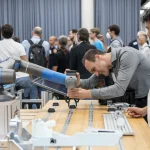The network is open to the entire robotics community and provides mechanisms of cascade funding for doubling its number of members over the next years.
euROBIN comprises 31 partners across 14 countries. It is coordinated by the Institute of Robotics of Mechatronics of the German Aerospace Center and includes highest-profile research institutions as well as outstanding industrial partners across sectors.
The network was awarded $12.5 million by the EU and Switzerland in total and launched on July 1st, following a call in 2021.
“Imec has a lot of relevant technologies for making robots interact and explore unstructured environments,” says Imec’s Bram Vanderborght, “ourvleading robotics and AI researchers developing applications as cobots, exoskeletons, social robots, drones and soft robots will be involved.”
euROBIN focuses on making cognition-enabled robotics solutions better transferable and reusable among scientists and by new industry.
Experts from the European robotics and AI research community will share their algorithms and data (ranging from abstract representations to specific maps and pre-trained models).
Transfer of software and models between robots and research groups is central to the project: By bringing research centres together, the network seeks to address the fragmentation of the European AI in Robotics landscape and facilitate technology transfer.
Software, data and knowledge will be exchanged over the EuroCore repository, designed to become a central platform for robotics in Europe. euROBIN thus creates a sustainable network fostering exchange and inclusion.
The relevance of the scientific outcomes will be demonstrated in three application domains that promise to have substantial impact on industry, innovation, and civil society in Europe. This includes providing solutions to global challenges such as using robotics in manufacturing and recycling, personal home assistance and the impacts of urbanisation, for example in terms of logistics.
Advances are made measurable through cooperative competitions. Teams will publicly compete on visionary and challenging application on one hand, but the competition rules will be made such that exchange of knowledge, data, and results between teams is equally valued to the mere task performance. If, for example, one teams generates a map of the test environment and another team reuses it, instead of regenerating it from scratch, both teams will gain points.
An essential element is cascade funding opening up to the community at large the possibility to contribute scientific solutions and participate in the challenges.
The network consists of:
• DEUTSCHES ZENTRUM FUR LUFT – UND RAUMFAHRT EV DE- KARLSRUHER INSTITUT FUER TECHNOLO
• INSTITUT NATIONAL DE RECHERCHE EN INFORMATIQUE ET AUTOMATIQUE FR
• COMMISSARIAT A L ENERGIE ATOMIQUE ET AUX ENERGIES ALTERNATIVES FR
• TEKNOLOGISK INSTITUT DK
• CESKE VYSOKE UCENI TECHNICKE V PRAZE CZ
• C.R.E.A.T.E. CONSORZIO DI RICERCA PER L’ENERGIA L AUTOMAZIONE E LE TECNOLOGIEDELL’ELETTROMAGNETISMO IT
• IMEC BE
• KUNGLIGA TEKNISKA HOEGSKOLAN SE
• ORBONNE UNIVERSITE FR
• OREBRO UNIVERSITY SE
• CENTRE NATIONAL DE LA RECHERCHE SCIENTIFIQUE CNRS FR
• ASSOCIACAO DO INSTITUTO SUPERIOR TECNICO PARA A INVESTIGACAO E DESENVOLVIMENTO PT
• UNIVERSITA DI PISA IT
• UNIVERSIDAD DE SEVILLA ES
• FONDAZIONE ISTITUTO ITALIANO DI TECNOLOGIA IT
• TECHNISCHE UNIVERSITAET MUENCHEN DE
• FUNDACION TECNALIA RESEARCH & INNOVATION ES
• UNIVERSITEIT TWENTE NL
• INSTITUT JOZEF STEFAN SI
• ASTI MOBILE ROBOTICS SA ES
• DHL Express Spain, S.L.U. ES
• PAL ROBOTICS SL ES
• VOLKSWAGEN AKTIENGESELLSCHAFT DE
• UNIVERSITAET BREMEN DE
• FRAUNHOFER GESELLSCHAFT ZUR FOERDERUNG DER ANGEWANDTEN FORSCHUNG E.V. DE
• FUNDINGBOX ACCELERATOR SP ZOO PL
• SIEMENS AKTIENGESELLSCHAFT DE
• MATADOR INDUSTRIES AS SK
• ECOLE POLYTECHNIQUE FEDERALE DE LAUSANNE CH
• EIDGENOESSISCHE TECHNISCHE HOCHSCHULE ZUERICH CH
